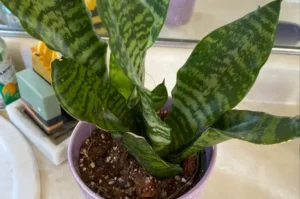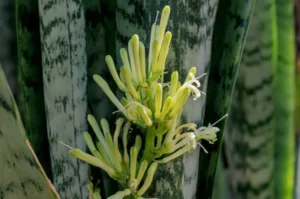Snake plants, also known as Sansevieria or Dracaena trifasciata, are famous for being nearly indestructible. However, even the toughest houseplants can suffer when they’re not cared for properly. If you’re a new snake plant parent, it’s easy to make a few rookie mistakes. This guide will walk you through the most common errors and show you how to avoid them, so your snake plant not only survives but thrives.
1. Overwatering Your Snake Plant
The Mistake: Snake plants are succulents. One of the biggest mistakes new owners make is watering too frequently.
Why It’s a Problem: Overwatering causes root rot, which can kill your plant silently. Since snake plant roots hold moisture, they don’t need frequent watering.
The Solution: Only water your plant when the top 2-3 inches of soil feel dry. In winter, you can go weeks without watering. Always use pots with drainage holes.
2. Using the Wrong Soil Type
The Mistake: Planting your Dracaena trifasciata in regular potting soil.
Why It’s a Problem: Regular soil holds too much moisture, which can lead to rot.
The Solution: Use a cactus or succulent mix that drains quickly. You can also mix regular soil with sand or perlite to improve drainage.
3. Ignoring Light Requirements
The Mistake: Placing your snake plant in very low light or direct hot sun.
Why It’s a Problem: Snake plants are low-light tolerant but not light-proof. Too much direct sun scorches the leaves; too little light slows growth.
The Solution: Place your Sansevieria in bright, indirect light. It can adapt to low light but thrives in medium light conditions.
4. Not Repotting Snake Plant Pups
The Mistake: Letting snake plant pups overcrowd the pot.
Why It’s a Problem: Pups (baby plants) compete for nutrients and space, which can stunt growth.
The Solution: When you see new pups growing at the base, gently separate and replant them. Use a clean knife or shears, and let the cut area dry before replanting.
5. Confusing Flowering with a Problem
The Mistake: Panicking when your snake plant starts flowering.
Why It’s a Problem: Some people think flowering is a sign of plant distress.
The Truth: Snake plant flowering is rare but not harmful. It often happens when the plant is slightly stressed but mature and well-established.
The Solution: Enjoy it! Flowering means your Dracaena trifasciata is doing well. Keep care consistent, and don’t overreact.
6. Over-Fertilizing
The Mistake: Feeding your plant too often.
Why It’s a Problem: Too much fertilizer leads to salt build-up and can burn the roots.
The Solution: Feed your snake plant only during the growing season (spring and summer) using a diluted cactus fertilizer once a month. Avoid fertilizing in fall and winter.
7. Neglecting Pest Control
The Mistake: Thinking tough plants can’t get pests.
Why It’s a Problem: Snake plants can attract spider mites and mealybugs, especially in dusty or overly humid conditions.
The Solution: Wipe leaves regularly, inspect for bugs, and treat infestations with neem oil or insecticidal soap.
8. Ignoring Temperature and Humidity
The Mistake: Placing your plant near cold drafts or heaters.
Why It’s a Problem: Sudden temperature changes can shock your snake plant.
The Solution: Keep your Sansevieria in temperatures between 60–80°F (16–26°C). Avoid placing it near AC vents or radiators.
Frequently Asked Questions (FAQs)
What are snake plant pups?
Pups are baby plants that grow from the base. You can separate and repot them.
Is Sansevieria the same as Dracaena trifasciata?
Yes, they are the same plant. The name changed due to botanical reclassification.
Conclusion
Snake plants are tough but not foolproof. Most problems new owners face are easy to avoid with a little knowledge. Remember: less water, the right soil, moderate light, and occasional attention are all it takes. Whether you’re managing snake plant pups or witnessing a rare snake plant flowering, proper care will keep your Sansevieria happy and healthy.
Keep these tips in mind, and your Dracaena trifasciata will be a stunning, low-maintenance star in your indoor garden.






